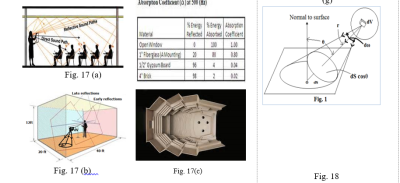Course description
Acoustics is the branch of physics that deals with the process of generation, reception and propagation of sound. This branch of physics is closely related to various branches of engineering. For example, architectural acoustics, which is dealing with the design and construction of buildings, recording studios, television broadcasting stations, music halls, operas, etc. (Fig. 17 a, b, c, d).
Reverberation: Prior to 1900, architects or building engineers paid very little or no consideration at all to the acoustic properties of rooms or halls. Wallace C. Sabine, Professor of Physics, Harvard University felt that by far the most important factor contributing to the acoustic badness of a building is excessive reverberation. Reverberation means the prolonged reflection of sound from the walls, floor and ceiling of a room. When sound is generated in a room, the waves travel towards the walls, etc. and are reflected again with a small loss in energy. A wave may suffer two or three hundred reflections before it becomes inaudible (Fig. 17 a, b). Therefore, the quality of the sound received by the listener is the combined effect of direct and reflected waves. Thus, so far as the listener is concerned the sound continues to persist for sometime even if it is cut off at the source. This persistence of audible sound after the source has ceased to operate is referred to as reverberation. Figs 17 (e-h) show the protection from reverberation
Sabine’s reverberation formula: Let E be the average energy density i.e., the average energy per unit volume inside an enclosure. Since the energy is homogeneously distributed inside the enclosure, then in any element of volume dV (Fig. 18), the amount of energy is E.dV. Out of this amount of energy, the fraction moving in a direction which will ultimately pass through the element of area dS is (dω/4π).E.dV, where dω is the solid angle subtended by dS at the element of volume dV and being the total solid angle that can be subtended at a point.
Waves and Oscillations
Q1. Define periodic motion. Give example.
Q2. Discuss the characteristics of S. H. M.
Q3. Establish the differential equation of motion of a body executing simple harmonic motion.
Q4. Show that the time period of a particle executing S.H.M is .
Q5. Show that the time period of oscillation of a mass-spring system is given by .
Q6. Show that the reduced mass of a two-body oscillating system executes simple harmonic motion.
Q7. Show that for small angular displacement the oscillation of a torsion pendulum is simple harmonic.
Q8. Obtain an expression for the time period of the oscillation of a torsion pendulum.
Q9. Show that the mechanical energy (total energy) remains conserved for a body which executing simple harmonic motion.
Q10. Show that the average value of kinetic and potential energies is same but half the mechanical energy of the harmonic oscillator.
Q11. Obtain an expression for the resultant displacement of a particle which is being simultaneously acted upon by two simple harmonic vibrations of same frequency but different phase and amplitude. What happens if the two vibrations are (i) in the same phase, (ii) in opposite phase and (iii) in opposite phase with their amplitudes being equal?
Q12. Derive a general expression for the resultant vibration of a particle simultaneously acted upon by two initially perpendicular simple harmonic vibrations, having the same time period but different amplitudes and phase angles. What happens if the phase difference is (i) 0, (ii) π/4, (iii) π/2 radians?
Q13. What are the Lissajous’ figures?
Q14. What is meant by a damping or a dissipative force?
Q15. What are the free undamped and damped vibrations?
Q16. Establish the differential equation of a damped harmonic oscillator.
Q17. What is forced vibration? Write the dependence of the amplitude of forced vibration.
Q18. Establish the differential equation of motion for forced vibration in the presence of damping force.
Q19. What is meant by resonance? Give example.
Q20. Discuss about the wave motion.
Q21. Derive the expressions for a plane progressive wave.
Q22. Define phase velocity.
Q23. Show that for a single wave in any given medium, wave velocity = phase velocity.
Q24. Define group velocity. Give example.
Q25. Derive the differential equation of one dimensional progressive wave motion.
Q26. Show that the intensity of a plane progressive wave is given by , where the symbols have their usual meanings.
Q27. Discuss the formation of stationary waves at fixed and free boundary.
Q28. What are reverberation and reverberation time?
Q29. Give the theory of growth and decay of sound inside a room, and hence obtain an expression for Sabine’s reverberation formula.


















